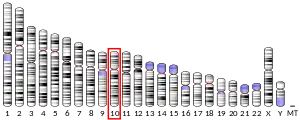MASTL
MASTL is an official symbol provided by HGNC for human gene whose official name is micro tubule associated serine/threonine kinase like. This gene is 32,1 kbps long. This gene is also known as GW, GWL, THC2, MAST-L, GREATWALL. This is present in mainly mammalian cells like human, house mouse, cattle, monkey, etc. It is in the 10th chromosome of the mammalian nucleus. Recent studies have been carried on zebrafish and frogs. This gene encodes for the protein micro tubule associated serine/threonine kinase and its sub-classes.
Micro-tubule-associated serine/threonine protein kinase is a mammalian enzyme which was first discovered in Drosophila as an essential kinase (great wall) for correct chromosome condensation and mitotic progression. The EC number for this enzyme is 2.7.11.12. This enzyme is active during mitotic division and is mainly localized in the nucleus during interphase. They get dispersed into the cytoplasm upon the degradation of nuclear envelope during mitosis. The MASTL depleted cells are delayed by RNAi in G2 phase and show a decreased condensation of the chromosomes. RNAi cells which pass through the mitosis, might not get separated into their sister chromatids in anaphase. This causes the chromatin to be trapped in the cleavage furrow and form 4N G1 cells due to cytokinesis failure. This enzyme enhances the cyclin B1-Cdk1-dependent mitotic phosphorylation events during mitosis.[5]
Although Mastl kinase is not essential for metaphase entry, it is required for its maintenance by sustaining spindle assembly checkpoint signaling.[6] Suppression of protein phosphatase 2A activity by Mastl/Arpp19/ENSA pathway leads to sustained high level of Cdk1 substrate phosphorylation until anaphase. It also provides the timely activation of APC/C during Meiosis I and Cdk1 reactivation in meiosis II.[7]
Mutation in the gene
A missense mutation in the MASTL gene can lead to an autosomal dominant inherited thrombocytopenia. The mutation is due to the change in amino acid glutamic acid at 167 to aspartic acid. Common phenotype of a mild thrombocytopenia patient is the decrease average plate counts of 60,000 platelets per ml of blood.
Uses in the therapeutic field
MASTL enzyme is also used for therapeutic applications such as cancer progression and tumor recurrence after free cancer therapy and this enzyme can be of higher value in the therapeutic market.[8]
References
- GRCh38: Ensembl release 89: ENSG00000120539 - Ensembl, May 2017
- GRCm38: Ensembl release 89: ENSMUSG00000026779 - Ensembl, May 2017
- "Human PubMed Reference:". National Center for Biotechnology Information, U.S. National Library of Medicine.
- "Mouse PubMed Reference:". National Center for Biotechnology Information, U.S. National Library of Medicine.
- Voets; Wolthuis (2010). "MASTL is the human ortholog of Greatwall kinase that facilitates mitotic entry, anaphase and cytokinesis". Cell Cycle. 9 (17): 3591–3601. doi:10.4161/cc.9.17.12832. PMID 20818157.
- Diril; Bisteau; Kitagawa (2016). "Loss of the Greatwall kinase weakens the spindle assembly checkpoint". PLOS Genetics. 12 (9): e1006310. doi:10.1371/journal.pgen.1006310. PMC 5025047. PMID 27631493. S2CID 36386949.
- Adhikari; Diril; Busayavalasa (2014). "Mastl is required for timely activation of APC/C in meiosis I and Cdk1 reactivation in meiosis II" (PDF). J Cell Biol. 206 (7): 843–853. doi:10.1083/jcb.201406033. PMC 4178961. PMID 25246615. S2CID 11425498.
- Wang; Luong; Giannini; Peng (2014). "Mastl kinase, a promising therapeutic target, promotes cancer recurrence". Oncotarget. 5 (22): 11479–11489. doi:10.18632/oncotarget.2565. PMC 4294390. PMID 25373736.
Further reading
- Maruyama K, Sugano S (1994). "Oligo-capping: a simple method to replace the cap structure of eukaryotic mRNAs with oligoribonucleotides". Gene. 138 (1–2): 171–4. doi:10.1016/0378-1119(94)90802-8. PMID 8125298.
- Suzuki Y, Yoshitomo-Nakagawa K, Maruyama K, et al. (1997). "Construction and characterization of a full length-enriched and a 5'-end-enriched cDNA library". Gene. 200 (1–2): 149–56. doi:10.1016/S0378-1119(97)00411-3. PMID 9373149.
- Savoia A, Del Vecchio M, Totaro A, et al. (1999). "An autosomal dominant thrombocytopenia gene maps to chromosomal region 10p". Am. J. Hum. Genet. 65 (5): 1401–5. doi:10.1086/302637. PMC 1288293. PMID 10521306.
- Drachman JG, Jarvik GP, Mehaffey MG (2000). "Autosomal dominant thrombocytopenia: incomplete megakaryocyte differentiation and linkage to human chromosome 10". Blood. 96 (1): 118–25. doi:10.1182/blood.V96.1.118. PMID 10891439.
- Strausberg RL, Feingold EA, Grouse LH, et al. (2003). "Generation and initial analysis of more than 15,000 full-length human and mouse cDNA sequences". Proc. Natl. Acad. Sci. U.S.A. 99 (26): 16899–903. Bibcode:2002PNAS...9916899M. doi:10.1073/pnas.242603899. PMC 139241. PMID 12477932.
- Gandhi MJ, Cummings CL, Drachman JG (2004). "FLJ14813 missense mutation: a candidate for autosomal dominant thrombocytopenia on human chromosome 10". Hum. Hered. 55 (1): 66–70. doi:10.1159/000071812. PMID 12890928. S2CID 30097740.
- Ota T, Suzuki Y, Nishikawa T, et al. (2004). "Complete sequencing and characterization of 21,243 full-length human cDNAs". Nat. Genet. 36 (1): 40–5. doi:10.1038/ng1285. PMID 14702039.
- Deloukas P, Earthrowl ME, Grafham DV, et al. (2004). "The DNA sequence and comparative analysis of human chromosome 10". Nature. 429 (6990): 375–81. Bibcode:2004Natur.429..375D. doi:10.1038/nature02462. PMID 15164054.
- Gerhard DS, Wagner L, Feingold EA, et al. (2004). "The status, quality, and expansion of the NIH full-length cDNA project: the Mammalian Gene Collection (MGC)". Genome Res. 14 (10B): 2121–7. doi:10.1101/gr.2596504. PMC 528928. PMID 15489334.
- Beausoleil SA, Villén J, Gerber SA, et al. (2006). "A probability-based approach for high-throughput protein phosphorylation analysis and site localization". Nat. Biotechnol. 24 (10): 1285–92. doi:10.1038/nbt1240. PMID 16964243. S2CID 14294292.



